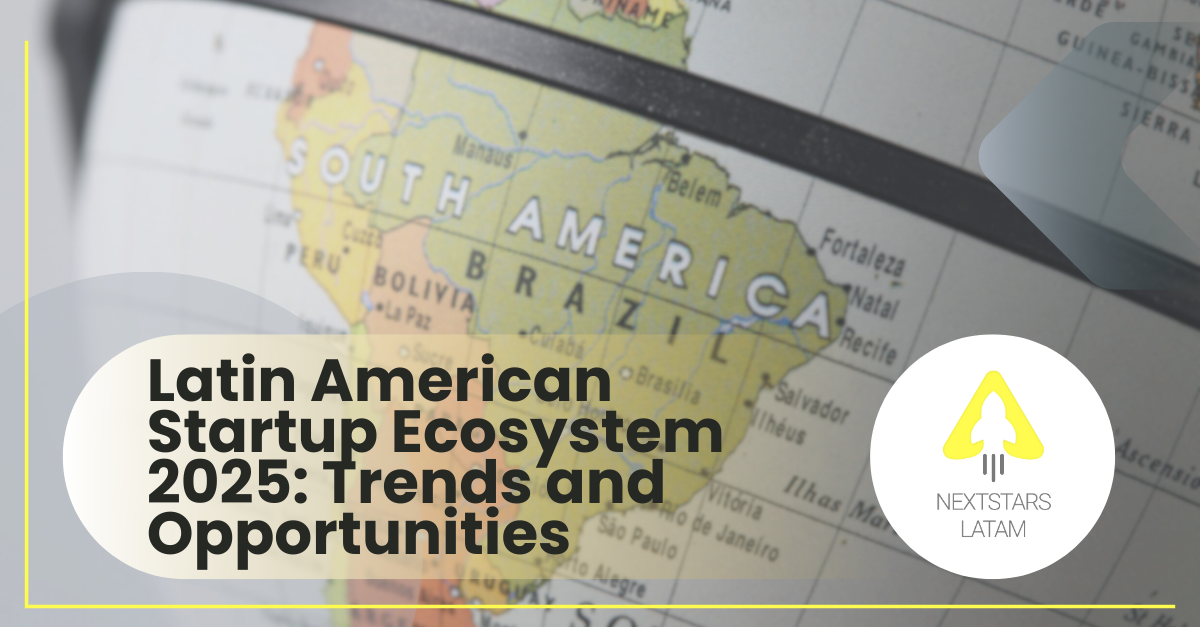Latin America’s startup scene is large and still growing. The region spans 20+ countries with ~660 million people (primarily Spanish/Portuguese speakers) and rapidly rising Internet/mobile use. After a 2021 funding peak (~$16B), VC activity dipped but stabilized. LAVCA reports roughly $4.5 billion deployed across ~750 deals in 2024 (only slightly above 2023’s $4.2B), and roughly $1B per quarter since late 2022. Funding remains concentrated: Brazil and Mexico together drew ~70% of LATAM VC dollars. Early-stage rounds (seed/Series A) make up most transactions, and LAVCA notes nearly 500 startups raised their first VC round in the past 18 months. Meanwhile, late-stage financing showed a comeback: Q4 2024 saw about $1B in Series C+ funding – the highest quarterly late-stage total since 2021. A report by Endeavor/Glisco found LATAM startup funding grew 26% in 2024, outpacing Europe, driven by larger rounds even as deal counts fell. In short, Latin America’s ecosystem has “fewer rounds, but more capital”: big growth deals dominate, even as seed-stage funding remains selective.
Leading Countries: Brazil, Mexico, Colombia, Chile, Argentina
- Brazil: By far the largest market, with a huge home economy and many tech unicorns (e.g. Nubank, Mercado Libre, 99, iFood). Brazilian startups raised roughly $2.0 billion in 2024 (versus $1.2B in Mexico). In Q3 2025 Brazil surged, raising $692 million (up 92% QoQ) and reclaiming the top spot in LATAM funding. Key sectors are fintech (Nubank, Stone Pagamentos, PagSeguro), e-commerce (Mercado Libre, VTEX), enterprise SaaS (Omie, ContaAzul) and others. For example, Omie (SME cloud software) closed a $160M Series D in Sept 2025 at a $700M valuation. Brazil’s deep talent pools and improving digital infrastructure make it attractive, though investors note competition and regulatory complexity.
- Mexico: The second-biggest ecosystem, now neck-and-neck with Brazil. In early 2025 Mexico led the region: Q2 2025 funding hit $437 M (85% YoY growth), the first time since 2012 that Mexico outearned Brazil. LAVCA notes Mexico “overtook Brazil in total VC dollars for the first time in 15 years.”. Large Mexican fintechs (Clip, Konfío, Stori, Klar) and payments players dominate. For example, in 2024 fintech Clip and food-delivery Justo each raised nine-figure rounds. The $100M+ deals keep coming: Q3 2025 saw Mexican bank Kapital raise $100M at a $1.3B valuation[1]. Mexico’s proximity to the U.S., growing middle class and push for financial inclusion drive these trends. (A recent survey found fintech remains Mexico’s largest VC category, with proptech and software growing fastest.)
- Colombia: A smaller but dynamic hub. Bogota-born Rappi (a delivery “super-app” in 9 countries) remains its best-known startup. In 2024 Colombian tech raised about $0.5 billion (with fintech ~75% of that). The public Medellín tech park Ruta N and government apps.co incubator support local founders. Key sectors include fintech (Daviplata, Movii), logistics (Liftit), and AgTech. Recent investments include a $186M late round for Colombian fintech ADDI. Colombia benefits from relative policy stability and is often a launchpad for regional expansion.
- Chile: A well-developed startup culture with strong public support. Chilean startups raised around $0.18 billion in 2024. The country is famous for its pro-entrepreneurship programs (CORFO’s Start-Up Chile, government grants) and its stable regulations. Leading sectors include fintech (Fintual, Khipu), AgTech/green tech, and enterprise software. Start-Up Chile has helped hundreds of startups (foreign and local) over the past decade, attracting global entrepreneurs. Corporations and investors from the U.S. and Europe often fund Chilean founders, as Chile is seen as a testbed for the wider Spanish-speaking market.
- Argentina: Despite macroeconomic challenges (inflation, volatility), Argentina punches above its weight. Tech companies raised roughly $0.4 billion in 2024. The ecosystem boasts some of LATAM’s biggest names – Mercado Libre (e-commerce), Despegar (travel), OLX, and digital bank Ualá. In fact, Ualá’s 2024 funding of $330M accounted for ~73% of Argentina’s entire VC haul that year. Fintech and edtech are hot segments (e.g. increase in companies like Walaxy, NALA). Argentina’s highly educated workforce and strong developer base attract venture funds (Kaszek Ventures, NXTP, etc.), though economic policy remains a risk factor.
Other hubs (Peru, Uruguay, Costa Rica, etc.) are smaller but growing. LAVCA notes emerging tech centers beyond the big five – Montevideo (Uruguay) is one of the fastest-growing startup cities due to tech-friendly regulation, and countries like Peru and Colombia are nurturing new clusters in Lima and Medellín.
Investment Trends and Valuations
Latin America’s VC funding has recovered from the 2021 trough. By LAVCA’s accounting, annual VC in LATAM climbed from $8.0B in 2022 to about $8.5B in 2024 (though LAVCA’s “tech trends” report shows $4.5B – differences reflect definitions). Either way, 2023–24 levels (~$4–5B/year disclosed) are well below the 2021 peak. Deal-flow has shifted: late-stage (Series C+) rounds surged late 2024 into 2025, while seed rounds remain scarce. For example, Crunchbase data show $961M invested in Q2 2025 (across all stages) – +16% YoY – and about $1.0B in Q3 (+21% YoY). In these quarters, growth rounds led the way ($547M in Q2, up strongly from 2024; and $477M in Q3, up 176% YoY). Seed/angel funding, by contrast, only saw $105M in Q3 (down 47% YoY), indicating investor caution at early stages. As one report phrased it, 2024 had “fewer rounds, but more capital” – meaning rounds are larger on average.
Valuations reflect this maturity. A handful of companies remain near-unicorn. In Mexico, Klar closed an $800M valuation on its $150M raise, and Toku (AI banking) fetched nine figures. In Brazil, Omie hit $700M post-money. Late 2025 Q3 produced a crop of nine-figure deals: Brazil’s Omie ($160M), Kapital ($100M to a $1.3B valuation) and Canopy ($100M) all closed rounds[1]. These growth financings signal that top-tier companies are still commanding high prices, even as overall median valuations have cooled from 2021 highs. Many startups now emphasize path to profitability, reflecting tighter capital: seasoned founders took 42% of 2023–24 dollars (vs 23% in 2021).
Hot Sectors
Fintech dominates Latin venture dollars. LAVCA data show fintech absorbing about 61% of all tech-sector VC (2020–2024). The reasons are clear: vast unbanked populations, legacy banking gaps, and a booming middle class eager for digital finance. In 2024, seven of the top 10 LATAM funding rounds were fintech deals (Ualá, Stori, ADDI, Asaas, Contabilizei, Celcoin, Buap, among others). This includes digital banks, payment platforms, insurtech and neobanks. Fintech’s appeal is region-wide: for instance, Mexican ventures Kavak (auto-financing) and Bitso (crypto), and Brazilian C6 and PicPay all raised large rounds recently.
Beyond fintech, e-commerce and digital commerce remain huge. Mercado Libre (Argentina), Americanas/Viavarejo (Brazil), and MercadoPago (payments) exemplify this. LAVCA notes e-commerce is consistently the second-largest vertical by deal count (though far behind fintech by dollars). COVID-19 accelerated online retail, and startups in last-mile logistics and B2B marketplaces (e.g. Loft, Frubana) are growing fast.
Software and enterprise tech are rising. Cloud/SaaS startups (especially for SMEs) draw investor interest. The Omie (B2B SaaS) and Contabilizei (SME accounting) deals show this trend. ICT services also figure prominently in country breakdowns (e.g. Colombia’s $68M in IT/data startups).
Other emerging sectors: HealthTech is booming. Latin America’s digital health market is growing ~37.6% in 2024 (compared to ~5.5% global), driven by telemedicine, diagnostics and insurance solutions. Brazil and Mexico host ~78% of healthtech startups. AgTech/Cleantech and Mobility/Logistics attract growing VC: LAVCA’s top-10 verticals list includes agriculture tech and smart mobility (each ~$120M+ in 2020–24). EdTech and PropTech are smaller but active niches (e.g. e-learning platforms, real estate fintech). Overall, any tech that can leapfrog infrastructure gaps (AI, mobile-first, crypto payments, etc.) is of high interest. Indeed, an AWS/Crunchbase analysis notes that many new LATAM startups are “AI-first,” leveraging global tech stacks from day one[2].
Opportunities for Founders & Investors
The entrepreneurial opportunity in LATAM often stems from solving big societal needs. As one expert put it, “Latin America’s greatest opportunities lie within its greatest deficiencies — in financial inclusion, insurance, healthcare, education…”. In practice, this means large addressable markets: hundreds of millions of unbanked people, under-served SMEs, and modernizing industries. Tech solutions that improve lives can scale rapidly. For founders, local knowledge is a plus – building products tailored to Latin consumer behavior.
From an investor’s view, LATAM offers scale and novelty. It has a young, tech-savvy population and fast-growing consumer markets. Stable economies (Brazil, Mexico, Chile, Colombia) are seen as lower-risk entry points[3]. Still, region-specific challenges exist: regulatory complexity, currency risk, and market fragmentation. Savvy VCs emphasize local expertise: for example, Gilgamesh Ventures notes they invest only in Brazil/Mexico “because these markets have the scale to deliver VC-sized outcomes,” and they back new companies built to expand regionally/globally[2]. And due diligence often focuses on founders’ resilience and regional networks[3].
Other advantages for investors: a strong network of serial entrepreneurs (alumni of big exits like MercadoLibre and Rappi are now founding new startups), growing amounts of local capital (a recent report highlighted more local LPs and a rise in corporate VC), and expanding exit channels (several LATAM tech firms are publicly traded or being acquired by multinational corporations). Indeed, more IPOs (on Nasdaq, NYSE or domestic exchanges) and high-profile M&A (e.g. Nu Holdings/Nubank, or Kaspi acquiring Brasil’s Stone) have created a blueprint for returns. A robust pipeline is forming: LAVCA notes some 500 startups raised their first VC round recently, promising future “graduations” to larger funding.
Key points for founders: large problems = large markets. Pitch emphasis on real impact and unit economics. Build cross-border ambitions early: many LATAM companies (fintech or SaaS) target not just their home country but neighboring markets and even overseas from day one[2]. Use the region’s superapps & platforms as springboards: open data initiatives, mobile money infrastructure, and a deepening internet economy.
Key points for investors: be ready for intensive founder engagement and patient capital. Look for sectors where LATAM can leapfrog (e.g. mobile payments instead of cash, telemedicine vs. legacy healthcare). Partnering with local accelerators (Endeavor, local Gov’t programs) and hiring regional teams can reduce entry barriers.
International Expansion and Partnerships
Latin American startups are increasingly eyeing global markets or cross-border synergies. Notable examples: Brazilian neobank Nubank (120M+ customers in Brazil, Mexico, Colombia) announced plans to enter the U.S., applying for a U.S. banking charter. Its goal is to serve both Latin American immigrants in the U.S. and new Americans with similar needs. More broadly, fintech and e-commerce founders often serve Hispanic diaspora or expand to other emerging markets.
There’s also a trend of global players leveraging LATAM startups to enter the region. For instance, Amazon took a stake in Colombia’s Rappi (a super-app in nine countries) to tap Rappi’s network and customer base. A marketing report notes Amazon’s move gives it “speed, reach, and local knowledge” across LATAM by partnering with Rappi. Such alliances help Latin startups get scale and help giants adapt locally.
In tech service exports, LATAM is also growing: many regional software companies and IT consultancies sell to U.S./European clients (often via nearshoring). Analysts estimate LATAM could capture a ~$100B+ opportunity by exporting AI-based services and software, leveraging its strong engineering talent pool (especially in Brazil, Argentina, Mexico). Educational platforms (e.g. online learning startups) and creative industries likewise look beyond borders.
Tech Adoption and External Partnerships
Latin American startups run on global tech stacks. Cloud computing (AWS, Google Cloud, Azure) is pervasive. For example, AWS and Google operate local data centers and run accelerators targeting Latino founders. In fact, AWS runs an “Impact Accelerator – Latino Founders” cohort (selected from the U.S. and Latin America) providing credits and mentoring. Founders commonly use open-source software, mobile-first tools, and increasingly AI/ML frameworks.
Global corporate partnerships are common. Chinese tech has entered the mix: Tencent led a $180M round in Nubank, and Nubank’s co-founder explicitly praised the deal for helping them “learn about the Chinese financial market”. In other words, Latin startups often import best practices via such deals. SoftBank’s Latin America fund (SoftBank Latin America Fund) is another major player, backing companies like Kavak (Mexico) and QuintoAndar (Brazil) with global money and expertise.
Moreover, big tech companies have local presence. Telefónica’s Wayra, Google for Startups (Latin America/Brazil programs) and others mentor regional founders. Business accelerators like 500 Startups LAC, Endeavor’s scale-up programs, and events (Web Summit Rio, South Summit Brazil, etc.) further integrate LATAM with global innovation networks. On the corporate side, local champions (e.g. MercadoLibre, global banks, logistics firms) collaborate with startups, often through VC arms or incubators.
Accelerators and Government Programs
Public support and accelerators are vital in LATAM. Chile’s Start-Up Chile (CORFO) is a pioneer, attracting international founders and funding hundreds of local startups over the past decade. It provides equity-free grants, visas and office space. Colombia’s Apps.co (MinTIC) has incubated many tech businesses, and the Medellín-based Ruta N tech hub offers R&D support. In Mexico, government initiatives like Prosoft offer funding for software companies, and state programs (e.g. INCmty in Monterrey) foster startups. Brazil has acceleration schemes (FINEP, InovAtiva Brasil, SEBRAE support) and a growing number of tech parks in cities like São Paulo, Florianópolis and Recife. Uruguay, Peru and others have also launched startup visas and incentives.
Corporate and NGO-led programs supplement these: for example, Google’s Launchpad Accelerator (LATAM), Microsoft’s startup labs, and multi-year funds from development banks (IDB Lab, CAF) inject capital into priority sectors (fintech, cleantech, inclusion). Major accelerators like 500 Startups LAC, Endeavor, and ACELERA (by Santander) are active regionally. Together, these create a robust ecosystem of mentorship, funding, and international connections for Latin founders.
Sources: Recent analyses and reports by Crunchbase, LAVCA, Endeavor/Glisco, Reuters, and industry news were used. Key data points were drawn from Crunchbase News funding reports, LAVCA’s 2025 Tech Trends report, and sector studies (IDB Lab, HolonIQ). Insights also reflect commentary by regional investors and experts[2], as well as coverage of major deals[1]. All figures are to Q3 2025 where available.
Read NextStars articles here.





